|
Copyright, Attention: This website and its contents contain intellectual property copyright materials and works belonging to the National First Ladies’ Library and Historic Site and to other third parties. Please do not plagiarize. If you use a direct quote from our website please cite your reference and provide a link back to the source.
First Lady Biography: Eliza Johnson

Eliza McCardle Johnson
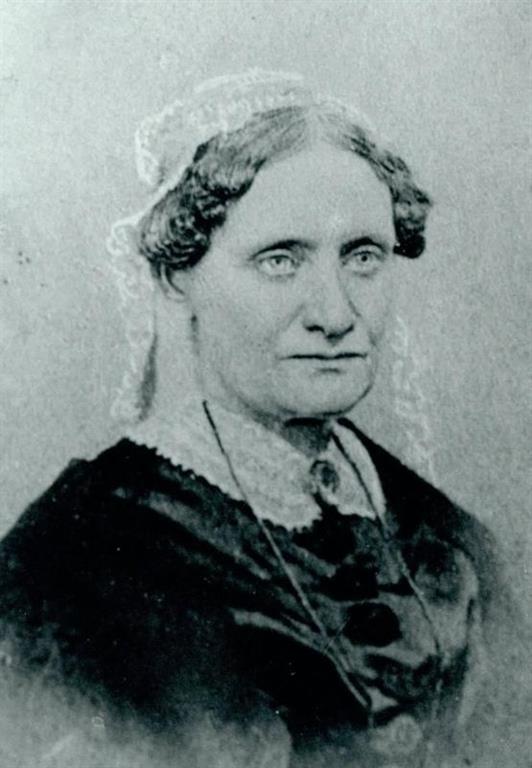
Birth Leesburg, Tennessee 4 October 1810 Ancestry Scotch-Irish, English, possibly Dutch; little to nothing has been definitively traced about Eliza Johnson’s ancestors because of the lack of any primary information about her parents and their origins. Her father’s surname is Scottish in origin and the region where he lived and where his daughter was born was heavily populated by Scotch-Irish laborers and pioneers, an ancestry which has traditionally been attributed to Eliza Johnson. One genealogical source, Andrew Johnson & E. McCardle Ancestry, published by Accelerated Indexing System in Salt Lake City, asserts that her mother’s ancestors “may have come” from Plymouth, Massachusetts which was first settled by religious “pilgrims” seeking religious freedom from England, as well as some Dutch families who joined the group when it came first to Holland. Although her mother’s maiden name “Phillips” is English, it may have been Anglicized from another national origin. Father John McCardle, date of birth unknown, Washington County, Tennessee. It is known that John McCardle worked as both a cobbler of different types of shoes and, according to records of 1824, as an innkeeper in the town of Warrensburg. It is also known that his income was low, though able to support himself, his wife and daughter. Nothing else is known of John McCardle and the few facts are not corroboratively documented; date of death, 1826, Warrensburg, Tennessee.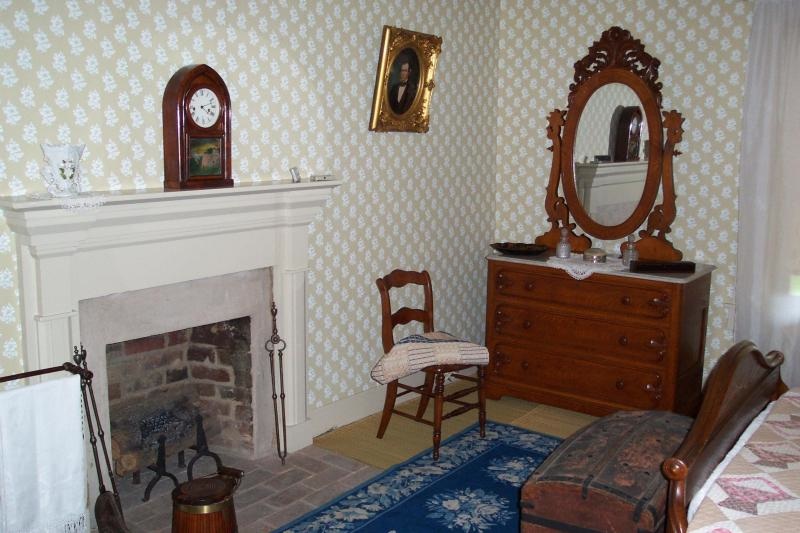
Mother Sarah Phillips, born 29 January 1789, Marshfield, Massachusetts; married 23 April 1809, place unknown; married secondly to Moses. L. Whitesides (birth and death unknown), 1833, Greeneville, Tennessee; died, place unknown. Eliza Johnson’s stepfather was known to be a silversmith who arrived in Greeneville, Tennessee from Ashville, North Carolina. What brought Sarah Phillips and, perhaps, her parents, from a small town in coastal Massachusetts to the relatively isolated mountain region of east Tennessee is unknown, as is how and where she met her husband; died, April, 1854, Greeneville, Tennessee. Siblings Eliza McCardle was the only child resulting from her parents’ marriage. There is no evidence that her mother’s second marriage produced any children, either, thus leaving Eliza Johnson without siblings or half-siblings. Eliza Johnson was the first of six wives of presidents who were born and raised as only children. The others were Ellen Arthur (who died before her husband’s presidency), Frances Cleveland, Grace Coolidge, Laura Bush and Nancy Reagan (whose mother’s remarriage brought a stepbrother to her family).Religion Methodist Education The Rhea Aademy, Greeneville, Tennessee, (date unknown, but within a range of 1816-1823)Details about Eliza Johnson’s education are not extant. Despite its being known as an academy, from the time of its founding in 1812 until the erection of a larger school building in 1825, the educational institution consisted of a small log cabin, where girls were educated, and the nearby Presbyterian Church where boys were taught. Among the classes available to Eliza McCardle were those in reading, spelling, writing, English, grammar, arithmetic, geography, composition, needlework, history, philosophy and, importantly, rhetoric. That Eliza Johnson wrote and spoke well and consistently read books on a wide range of subjects suggests she had something of a lengthy tenure as a Rhea Academy student. That she famously read books (along with newspapers) to her fiancé and husband Andrew Johnson might also indicate that she was still a student at the time they met in 1826 – and perhaps even as a young bride in 1827, for impoverished families did not expend their limited cash on books other than the Bible. While purely speculation, it may be that Eliza McCardle read to Andrew Johnson some of the schoolbooks she was given to use as a student. Life before Marriage: From the few facts about her early life that are known, it is apparent that Eliza McCardle Johnson was the first among few First Ladies born into poverty. Contrary to what was first written in 1881, however, it was not true that “her father had been dead for many years” at the time she first met her future husband in 1826, but rather that same year. However, both Eliza and her mother worked to supplement John McCardle’s income, both being craftswomen who shared in his trade of making cloth and leather sandals, as well as the more traditional women’s product of quilts, both types of items being made for local sale. This seems at odds with the fact that her paternal grandfather Phillip McCardle possessed enough property to deed one acre of land on which a Washington County, Tennessee Methodist Church could be raised. According to her daughter, Eliza Johnson also learned to grow and cultivate root vegetables and to cook well.Marriage:  17 May 1827, Warrenton, Tennessee; married to Andrew Johnson, tailor (born 29 December 1808, Raleigh, North Carolina; died 31 July 1875, Carter’s Station, Tennessee). In 1826, Eliza McCardle first met Andrew Johnson as he entered the town of Greeneville, searching for work as a tailor, along with his mother and stepfather. A popular legend claims that she told her friends that she found him appealing and might marry him. Johnson was unable to immediately find work in Greeneville, which he did in nearby Rutledge, where he worked for six months and maintained a courting correspondence with Eliza. He was able to find enough tailoring work to establish a business in a two-room house, using the front room for work and the back for living quarters, where he brought his new bride. At 16 years old, Eliza Johnson was the youngest-married First Lady. The couple was married by minister Mordecai Lincoln, the first cousin of Abraham Lincoln’s father. 17 May 1827, Warrenton, Tennessee; married to Andrew Johnson, tailor (born 29 December 1808, Raleigh, North Carolina; died 31 July 1875, Carter’s Station, Tennessee). In 1826, Eliza McCardle first met Andrew Johnson as he entered the town of Greeneville, searching for work as a tailor, along with his mother and stepfather. A popular legend claims that she told her friends that she found him appealing and might marry him. Johnson was unable to immediately find work in Greeneville, which he did in nearby Rutledge, where he worked for six months and maintained a courting correspondence with Eliza. He was able to find enough tailoring work to establish a business in a two-room house, using the front room for work and the back for living quarters, where he brought his new bride. At 16 years old, Eliza Johnson was the youngest-married First Lady. The couple was married by minister Mordecai Lincoln, the first cousin of Abraham Lincoln’s father.
Children: Five children, two daughters; three sons: Martha Johnson Patterson (1828 - 1901, see full biography below); Charles Johnson (1830 – 1863); Mary Johnson Stover (1832 – 1883, see full biography below); Robert Johnson (1834 – 1869); Andrew Johnson, Jr. (1852 – 1879) Life before the White House: Although Andrew Johnson had an inconsistent and limited formal education, he was able to read, write and speak at the time of his marriage. Eliza Johnson made her great and substantive contribution to the trajectory of his career in public service by helping to refine the quality of his written and spoken communicative skills. Their daughter Martha Patterson wrote of her parents in 1881 that, “it is a mistake she taught my father the alphabet as this he had acquired before leaving Raleigh…But little has been written about my mother as she always opposed any publicity concerning her private life. She was the stepping stone to all the honors and fame my father attained.” Eliza Johnson is quoted as clarifying, “I taught him to form the letters, but he was an apt scholar, and acquired all the rest of it for himself.” Finally, Andrew Johnson frequently credited his wife in public remarks with widening and deepening his education. Most accounts of Andrew Johnson’s early life consistently credit Eliza Johnson with training and helping hone him into an excellent public speaker, be it for formal speeches or debates, perhaps a result of her having learned rhetoric at the Rhea Academy. Both the training in formal writing and public speaking took place in their small home across the street from the tailor shop where he practiced his trade and earned a small wage to support them and their first child. 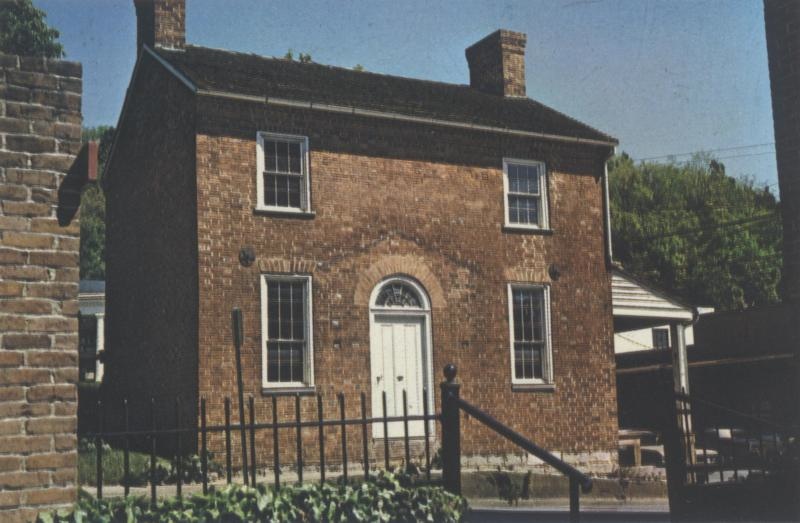 Immediately after their marriage, she was known to have successfully persuaded him to register as a member of the Greeneville College Debating Society. The practical experience led to his emerging as a spokesperson and leader of a workingman’s party he organized and his successful campaign and election as Alderman (1828-1830) and Mayor (1830-1833) of Greeneville. Immediately after their marriage, she was known to have successfully persuaded him to register as a member of the Greeneville College Debating Society. The practical experience led to his emerging as a spokesperson and leader of a workingman’s party he organized and his successful campaign and election as Alderman (1828-1830) and Mayor (1830-1833) of Greeneville.
Eliza Johnson is also credited with cautiously managing their finances, and by February, 1831 the couple were able to buy a larger home to accommodate their growing family, their second child being born that month. Four of her five children were born within seven years of her marriage. In addition to continuing to manage the family finances, she saw to repairs of the brick home and grew and harvested produce on the property, in addition to the traditional tasks of making clothing, cleaning and cooking. When Andrew Johnson moved from local to state political office, first as congressman for Greene and Washington Counties (1835-1837; 1839-1841) and then as senator (1841-1843), he resided in the state capital of Nashville during legislative sessions. Eliza Johnson, however, remained in Greeneville. However, when Andrew Johnson returned, and spoke to local residents at rallies, Eliza Johnson was described in one account as having been in attendance as her husband expounded on issues directly affecting the working poor. She was also reported to regularly read local, state and national newspapers in the evenings and taking an active role in deepening the education of both her sons and daughters beyond what they learned through formal education. 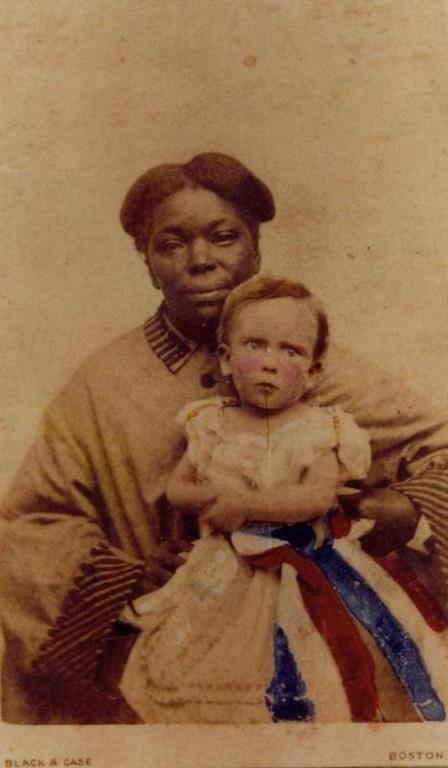 By 1840, Eliza Johnson was being assisted with her work at home by two African-American slaves identified only as “Dolly” and her half-brother “Sam,” legend claiming that the former had asked Johnson to purchase them, perhaps because of his local reputation for fairness. It seems unlikely that Eliza Johnson was consulted on the matter since she vehemently opposed the ownership of human beings, following a tenet of her Methodist faith. By 1840, Eliza Johnson was being assisted with her work at home by two African-American slaves identified only as “Dolly” and her half-brother “Sam,” legend claiming that the former had asked Johnson to purchase them, perhaps because of his local reputation for fairness. It seems unlikely that Eliza Johnson was consulted on the matter since she vehemently opposed the ownership of human beings, following a tenet of her Methodist faith.
She did likewise when Johnson moved to the national level of politics, being elected to the U.S. House of Representatives and lived in Washington during the winter and spring sessions. During the full ten years of his tenure as Congressman, it is known that she visited Washington but it is unclear for how long or what length of time. She did, however, encourage her eldest child Martha to join him and the young woman was placed in a girl’s school there (see her biography below). 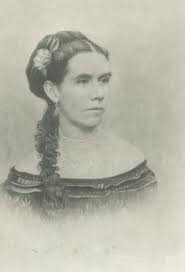 During vacations and weekends, Miss Johnson frequently accepted the invitations of First Lady Sarah Polk to participate in White House social events. Congressman Johnson had been a consistent supporter of his fellow Tennessean Democrat, President James Polk and the bond between their daughter and wife, respectively, reflected a mutual political trust between them. While it is known that Eliza Johnson did later interact with Sarah Polk, the extent of their acquaintance is unknown. During vacations and weekends, Miss Johnson frequently accepted the invitations of First Lady Sarah Polk to participate in White House social events. Congressman Johnson had been a consistent supporter of his fellow Tennessean Democrat, President James Polk and the bond between their daughter and wife, respectively, reflected a mutual political trust between them. While it is known that Eliza Johnson did later interact with Sarah Polk, the extent of their acquaintance is unknown.
In 1851, following his congressional career and return to Greeneville, the Johnsons purchased a large home in town. The following year, Eliza Johnson gave birth to the last of her five children. While it can only be speculative, her pregnancy or childbirth may have weakened her system and left her vulnerable to contracting or first displaying the lung disability of tuberculosis. By the next year, 1853, when Andrew Johnson was elected Governor of Tennessee (1853-1857), Eliza Johnson had to limit her physical movement and was unable to join him in Nashville. She was only 43 years old. At home, she also began to confront the evidence of alcoholism besetting her sons Charles (later a doctor, pharmacist and surgeon with the Union Army during the Civil War) and Robert (an attorney, who committed suicide eight weeks after his father’s presidency ended).  To what extent her tuberculosis became serious enough to limit Eliza Johnson’s life is speculative, but small clues might provide some indication. In warm weather, she was known to enjoy walking at the base of the nearby mountains with her youngest son. She arranged and attended her daughter Martha’s wedding and often visited her other married daughter and new grandchildren in a nearby county, though whether she took the available railroads, was driven or drove herself by horse and carriage is unknown. While her work at home was within the traditional realm of homemaking, it also required managerial skills like directing one of their male African-American slaves, Sam, who often directly challenged the smaller and weaker woman yet never contradicting her. Eliza Johnson also personally went to collect the rent money from tenants who leased property that she and Andrew Johnson had invested in. To what extent her tuberculosis became serious enough to limit Eliza Johnson’s life is speculative, but small clues might provide some indication. In warm weather, she was known to enjoy walking at the base of the nearby mountains with her youngest son. She arranged and attended her daughter Martha’s wedding and often visited her other married daughter and new grandchildren in a nearby county, though whether she took the available railroads, was driven or drove herself by horse and carriage is unknown. While her work at home was within the traditional realm of homemaking, it also required managerial skills like directing one of their male African-American slaves, Sam, who often directly challenged the smaller and weaker woman yet never contradicting her. Eliza Johnson also personally went to collect the rent money from tenants who leased property that she and Andrew Johnson had invested in.
When Andrew Johnson was elected to represent Tennessee in the United States Senate (1857-1862) and lived in Washington, D.C. again while that body was in session, Eliza Johnson again chose to remain home in Greeneville. There she continued her financial management of their property and investments and the social welfare work she supported through her Methodist Church. Being the central figure in a family of an adult and a young adult son (one other adult son went to Washington with his father), two married daughters and their husbands, and a brood of grandchildren that would eventually number five was also a vital source of fulfillment in her life, despite her husband’s constant absence from it.  Ironically, the only period of her husband’s long pre-presidential career in Washington during which Eliza Johnson decided to come to the capital city of the United States were the months of it collapsing into Civil War, following the secession of the southern states, including Tennessee, from the autumn of 1860 just prior to the presidential election of Abraham Lincoln and through the springtime of 1861, when South Carolina seceded from the U.S. and the Union fired on Fort Sumter. The period would also include the inauguration of Lincoln. As the spouse of the only U.S. Senator from the South remaining loyal to the Union despite his state’s secession, Eliza Johnson would have been invited to the White House and have met the new First Lady, Mary Lincoln. There is no record of whether this occurred or not. There is, however, an eyewitness account of her being with her husband in attendance at a speech on the South Lawn of the White House, delivered by President Lincoln. Ironically, the only period of her husband’s long pre-presidential career in Washington during which Eliza Johnson decided to come to the capital city of the United States were the months of it collapsing into Civil War, following the secession of the southern states, including Tennessee, from the autumn of 1860 just prior to the presidential election of Abraham Lincoln and through the springtime of 1861, when South Carolina seceded from the U.S. and the Union fired on Fort Sumter. The period would also include the inauguration of Lincoln. As the spouse of the only U.S. Senator from the South remaining loyal to the Union despite his state’s secession, Eliza Johnson would have been invited to the White House and have met the new First Lady, Mary Lincoln. There is no record of whether this occurred or not. There is, however, an eyewitness account of her being with her husband in attendance at a speech on the South Lawn of the White House, delivered by President Lincoln.
Despite being under Confederate Army authority, the people of eastern Tennessee, where the Johnsons lived, were largely loyal to the Union. With Senator Johnson speaking vigorously against the Confederacy and seeking Union protection of his region, Eliza Johnson became a target. Without warning, her Greeneville home was confiscated for use as sleeping quarters for Confederate Army troops. Forced from there, Eliza Johnson and her young son Frank and adult son Charles, had to seek shelter at the nearby Carter County home of her daughter and son-in-law, Mary and Daniel Stover, and three young children. The Stover home, however, was also located in the area controlled by the Confederate government.  In April of 1862, Eliza Johnson, along with other prominent Union families in that jurisdiction were given short notice to vacate by Confederate General Kirby Smith, who oversaw it. In one of her only remaining letters, Eliza Johnson responded formally but honestly that “in my present state of health, I know I can not undergo the fatigues of such a journey; my health is quite feeble, a greater portion of the time being unable to leave my bed.” Five months later, she wrote him again, this time declaring herself able to travel and requesting the necessary permits for movement within the Confederate-held regions and to cross into Union territory when necessary. In April of 1862, Eliza Johnson, along with other prominent Union families in that jurisdiction were given short notice to vacate by Confederate General Kirby Smith, who oversaw it. In one of her only remaining letters, Eliza Johnson responded formally but honestly that “in my present state of health, I know I can not undergo the fatigues of such a journey; my health is quite feeble, a greater portion of the time being unable to leave my bed.” Five months later, she wrote him again, this time declaring herself able to travel and requesting the necessary permits for movement within the Confederate-held regions and to cross into Union territory when necessary.
Starting in mid-September 1862, the privations endured by Eliza Johnson essentially made her a wartime refugee. For several nights, she and her daughter Mary Stover also prepared and smuggled food into nearby mountain caves where her son-in-law and his fellow Union military sought shelter and eluded detection by Confederates. In late September, she was detained for two days in Murfreesboro by Confederate General, Nathan B. Forrest which proved to be a degrading and harrowing episode. Having had no warning that the family would be detained in Murfreesboro, Eliza Johnson was literally forced to go door to door to seek to the homes of strangers and beg for shelter that night for herself and her family. Only begrudgingly was one home of Confederate sympathizers made available to them but denied the next night. On the second night, Eliza Johnson and her family were able to find shelter only in an abandoned restaurant, with no place to sleep, no food for sustenance, and no light. Eliza Johnson had apparently considered such a possibility, for she had brought candles from home and kept sandwich remnants from the previous day, which she gave her grandchildren to eat. Once permission from the Confederate capital in Richmond was wired to officials in Murfreesboro, Eliza Johnson and her family proceeded by train to Nashville, during which they were violently harassed and her sons threatened with death by fellow passengers who were Confederate sympathizers. Although she and her family were given safe refuge in Nashville, arriving there on 13 October 1862, Eliza Johnson was soon notified that the alcoholism of her adult son Robert Johnson had deteriorated his condition and threatened his Union Army appointment as a Colonel. Stationed with his military unit in Cincinnati, Ohio, determination of his case was delayed, due to the status of his father as a U.S. Senator. With Andrew Johnson seeking to coordinate matter from Washington, Eliza Johnson and her family members left Nashville for Cincinnati in November of 1862, to personally intercede on Robert Johnson’s behalf. From there, with her son Frank, Mary Stover, and her three Stover grandchildren, Eliza Johnson sought a health treatment at a sulfuric spa in Vevay, Indiana. Joined there by her son-in-law Daniel Stover in early 1863, the party proceeded to Louisville, Kentucky. The anxious months and exposure to the elements had worsened Eliza Johnson’s breathing problems and she decided to then proceed to Nashville in May, rather than unite with her husband in Washington, where the weather would further deteriorate her condition. Appointed by President Lincoln as Military Governor of Tennessee (1862-1865), Johnson made several dramatic references in public speeches to the treatment of his wife by the Confederate Army. This prompted deeper resentment of him and increased threats against his life. Andrew and Eliza Johnson had an emotional but brief reunion in Nashville when she arrived there with her family in May of 1863. He separated from them again weeks later, removing himself to Kentucky’s Union territory for his safety. Ongoing threats against him and their renewed separation nonetheless perpetuated anxiety for Eliza Johnson. 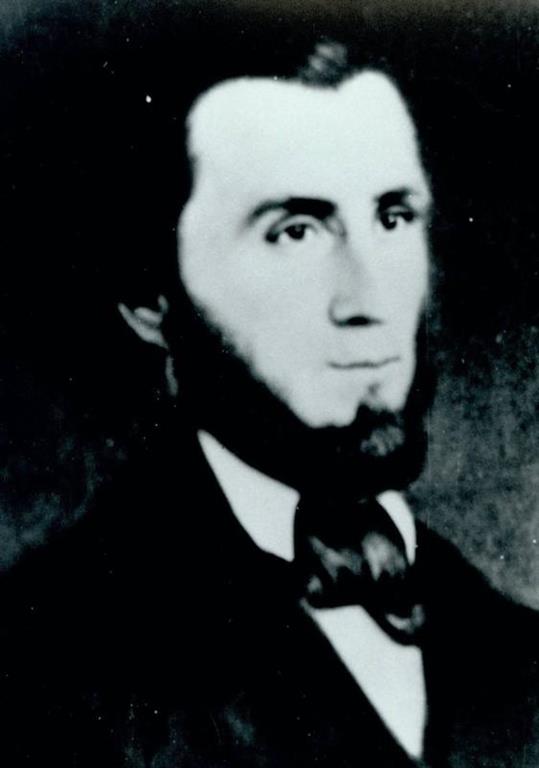 This was intensified in April of 1863 by the sudden death of their son Charles, killed instantly when his skull fractured after being thrown from a horse. Having moved successfully from publishing a small-Union newspaper to earning a medical degree and then being appointed a Union Army surgeon with the rank of Colonel, 33 year old Charles Johnson had become an especial point of pride for Eliza Johnson and his unexpected death was one from which she was said to have never emotionally recovered, forever sensitive even to the mention of his name. The one consolation during this period was that daughter Martha Patterson, her husband and two children rejoined Eliza Johnson and lived in the same home with her. This was intensified in April of 1863 by the sudden death of their son Charles, killed instantly when his skull fractured after being thrown from a horse. Having moved successfully from publishing a small-Union newspaper to earning a medical degree and then being appointed a Union Army surgeon with the rank of Colonel, 33 year old Charles Johnson had become an especial point of pride for Eliza Johnson and his unexpected death was one from which she was said to have never emotionally recovered, forever sensitive even to the mention of his name. The one consolation during this period was that daughter Martha Patterson, her husband and two children rejoined Eliza Johnson and lived in the same home with her.
Campaign and Inauguration:In early June 1864, Andrew Johnson was nominated as the National Union Party’s vice presidential candidate, on the ticket with President Lincoln who was seeking re-election. Eliza Johnson played no role in his campaign, a fact which stemmed not from disinterest but her role in handling a family crisis at the time. Robert Johnson’s alcoholism had so worsened that he was forced to resign as a Union Colonel. In August of 1864, Eliza Johnson brought him to the Lewis Sanitarium in Lexington, Massachusetts for recovery treatment, and simultaneous treatment for her tuberculosis and the first signs of it in her younger son Frank. After making the arduous wartime journey from Nashville to Boston, they first rested at a resort, “Pigeon Cove,” outside the city. Another tragedy soon hit the family when Mary Stover was widowed by the sudden death of her husband in December of 1864. 
Eliza Johnson remained in Nashville, rather than attend the Washington, D.C. swearing-in ceremony of Andrew Johnson as Vice President in March 1865. A month later, upon learning that Lincoln had been killed and of the conspiracy to kill members of his Administration, her daughter wrote to her father that, “Poor mother, she is almost deranged fearing that you will be assassinated.First Lady 15 April 1865 – 4 March 1869 55 years oldEliza Johnson arrived at the White House on 6 August 1865, with an entourage including her two sons, her two daughters, her remaining son-in-law and five grandchildren. Deferred to as the central figure of the presidential household, the new First Lady was given the first choice of rooms on the second floor and made the small northwest corner space her bedroom with the adjoining larger room as her sitting room. Her sitting room became the gathering place for her family. Among the relatively obscure First Ladies of the 19thcentury, few have been left with as distorted a legacy as Eliza Johnson. Small but key pieces of new documentation as well as a closer examination of original sources which led to this misreading of her White House incumbency may offer a more indepth and nuanced perspective on her. 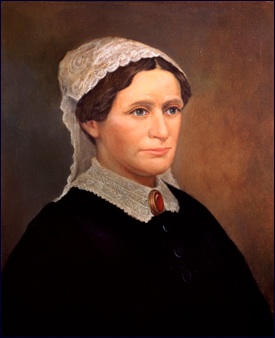 Before leaving Nashville, Eliza Johnson had conferred with her younger and more passive daughter Mary Stover and her older, efficient one Martha Patterson, who had years of experience in Washington life, in deciding the part each would play in the presidential household. The explicit evidence of this is from a letter to President Johnson from family friend Lucie Williams Polk, widow of the late President Polk’s younger brother. Lucie Polk reported while visiting the Nashville home of her sister-in-law, the former First Lady Sarah Polk, she “heard her speak of Mrs. Patterson who report says will do the honors…” Before leaving Nashville, Eliza Johnson had conferred with her younger and more passive daughter Mary Stover and her older, efficient one Martha Patterson, who had years of experience in Washington life, in deciding the part each would play in the presidential household. The explicit evidence of this is from a letter to President Johnson from family friend Lucie Williams Polk, widow of the late President Polk’s younger brother. Lucie Polk reported while visiting the Nashville home of her sister-in-law, the former First Lady Sarah Polk, she “heard her speak of Mrs. Patterson who report says will do the honors…”
Contrary to later, popular perception, Eliza Johnson did assume a public role as First Lady, but she restricted it to that of hostess at formal dinners and the visits of heads of state. Martha Patterson (see her full biography below) took on the task of hostess who appeared in the receiving line at the large open-house receptions to which the general public was admitted to meet the President. Mary Stover (see her full biography below) was to assist her sister at these public receptions, but also direct the tutoring and activities of her three young children and her young niece and nephew, as well as serving as daytime aide and companion to her mother in the First Lady’s suite. Nevertheless, both daughters were led at the direction of their mother. While Patterson did assume responsibility for determining how to restore some of the mansion’s glory on a limited federal budget, Eliza Johnson still oversaw the menus for both the family’s private meals and those served to guests, making a morning ritual of visiting the kitchens and interacting with the staff. Mrs. Johnson took more than a routine interest in cooking, and the former enslaved women who worked for the family i their Tennessee home credit her with teaching them finer skills in preparing various dishes, beyond the basics. Likewise, though Stover interacted with the tutor of the presidential grandchildren, Eliza Johnson met with the children in her sitting room, after their lessons.  Several factors likely contributed to this arrangement. First was the lingering personal sadness of Eliza Johnson over the death of her son Charles Johnson and that of Mary Stover over the even more recent death of her husband Daniel Stover. Eliza Johnson had suddenly been thrust into the status of president’s wife under circumstances discouraging her fullest participation. The lingering trauma of Lincoln’s murder has been overlooked as a factor in the cautious public venturing the family determined to play. A threshold was crossed which previous political conflicts had never ventured and its mournful shadow still cast a fear of potential violence against the President or his representative family members. To assure the new First Lady of not only her safety but that of her husband, her first public ceremony, in February of 1866, involved a unique presentation to serve as a reminder of her husband’s escape from the widespread conspiracy around Lincoln’s death. Produced by the Historical Society of Wisconsin, it was an extravagantly leather-bound volume of testimony from eyewitnesses and participants who helped secure Johnson’s safety, written out in calligraphy penmanship. Several factors likely contributed to this arrangement. First was the lingering personal sadness of Eliza Johnson over the death of her son Charles Johnson and that of Mary Stover over the even more recent death of her husband Daniel Stover. Eliza Johnson had suddenly been thrust into the status of president’s wife under circumstances discouraging her fullest participation. The lingering trauma of Lincoln’s murder has been overlooked as a factor in the cautious public venturing the family determined to play. A threshold was crossed which previous political conflicts had never ventured and its mournful shadow still cast a fear of potential violence against the President or his representative family members. To assure the new First Lady of not only her safety but that of her husband, her first public ceremony, in February of 1866, involved a unique presentation to serve as a reminder of her husband’s escape from the widespread conspiracy around Lincoln’s death. Produced by the Historical Society of Wisconsin, it was an extravagantly leather-bound volume of testimony from eyewitnesses and participants who helped secure Johnson’s safety, written out in calligraphy penmanship.
Certainly, Eliza Johnson’s physical condition was the most important factor determining her limited public role. Closer examination of the nature of her condition and activities during the Johnson Administration, however, refute the miscast perception of her life as being one curtailed to knitting while seated in her rocking chair, in her White House room. The source which established this skewed view, Ladies of the White House (1881) drew on an 1869 Chicago Republican newspaper account which stated: “Mrs. Johnson, a confirmed invalid, has never appeared in society in Washington. Her very existence is a myth to almost every one. She was last seen at a party given to her grandchildren. She was seated in one of the Republican Court chairs, a dainty affair of satin and ebony. She did not rise when the children or old guests were presented to her; she simply said, ‘My dears, I am an invalid,’ and her sad, pale face and sunken eyes fully proved the expression.” The Chicago Reporter article further makes two glaring errors, the first claiming that Eliza Johnson was older than her husband and the second being that she “taught the President to read.” Further, it was written in the Administration’s last days at which point characterizing her as an “invalid” was valid, but hardly reflected the sum of her time as First Lady. That, as the article states, she “has never appeared in society in Washington,” used terminology which meant social events of the residential and political elite yet ignored an unwritten coda which forbade the President and his wife from accepting invitations or appearing at public events, on the premise that they were the city’s social leaders whom all others deferred to. Lastly, the claim that “Her very existence is a myth toalmost every one,” is contradicted by the public mail addressed to her, the solicitation of her support for a charitable cause, and the spectrum of influential figures in politics and business whom she befriended or hosted as dinner guests. 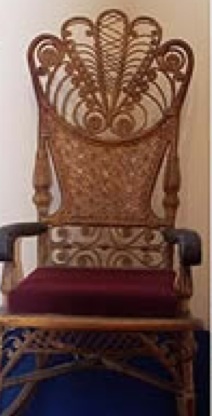 The nature of what was called “consumption” in relation to the First Lady but was becoming more widely known by its name today of tuberculosis. A bacterial infection of the lungs, Eliza Johnson’s activities suggest that she manifested a common pattern of the disease, a cycle where the lung tissue is destroyed and then repairs, allowing for greater and then poorer breathing capacity. This accounts for the seemingly conflicting reports of Eliza Johnson having to remain seated at events while at other times she made lengthy rail excursions throughout the eastern United States. In 1867, for example, she inexplicably traveled along the eastern seaboard, stopping in Philadelphia, New York, and Boston and also going west and south from Washington to Pittsburgh and Louisville. The nature of what was called “consumption” in relation to the First Lady but was becoming more widely known by its name today of tuberculosis. A bacterial infection of the lungs, Eliza Johnson’s activities suggest that she manifested a common pattern of the disease, a cycle where the lung tissue is destroyed and then repairs, allowing for greater and then poorer breathing capacity. This accounts for the seemingly conflicting reports of Eliza Johnson having to remain seated at events while at other times she made lengthy rail excursions throughout the eastern United States. In 1867, for example, she inexplicably traveled along the eastern seaboard, stopping in Philadelphia, New York, and Boston and also going west and south from Washington to Pittsburgh and Louisville.
However unpredictable, Eliza Johnson’s consumption waxed and waned during her tenure as First Lady but as it gradually worsened, she became sedentary and lived a more confined life towards the Administration’s end. The bacillus causing tuberculosis was not discovered until after her death. Still, less than a year before the Administration ended, Eliza Johnson was still presiding as First Lady at formal White House dinners, as documented by a new piece of evidence.  While it is established that Eliza Johnson hosted with the President a state dinner honoring Hawaii’s Queen Emma, one of the earliest-known printed invitation forms used by the White House, discovered in 2011, reveals that the First Lady’s presence that night was not a rare occurrence as has been previously believed. The invitation card begins with the pre-engraved words, “The President and Mrs. Johnson request the pleasure of [here the guests names were hand-written, in this case a Mr. and Mrs. Robinson] Company to Dine on [the day of the week was hand-written here, in this case, Friday] next at [here the time and date of the dinner was hand-written, in this case 6 o’clock March 14, 1868]. An Early Answer.” Julia Grant wrote that even if Eliza Johnson didn’t appear at the start of these, she “always came into the drawing room after the long state dinners to take coffee and receive the greetings of her husband’s guests.” While it is established that Eliza Johnson hosted with the President a state dinner honoring Hawaii’s Queen Emma, one of the earliest-known printed invitation forms used by the White House, discovered in 2011, reveals that the First Lady’s presence that night was not a rare occurrence as has been previously believed. The invitation card begins with the pre-engraved words, “The President and Mrs. Johnson request the pleasure of [here the guests names were hand-written, in this case a Mr. and Mrs. Robinson] Company to Dine on [the day of the week was hand-written here, in this case, Friday] next at [here the time and date of the dinner was hand-written, in this case 6 o’clock March 14, 1868]. An Early Answer.” Julia Grant wrote that even if Eliza Johnson didn’t appear at the start of these, she “always came into the drawing room after the long state dinners to take coffee and receive the greetings of her husband’s guests.”
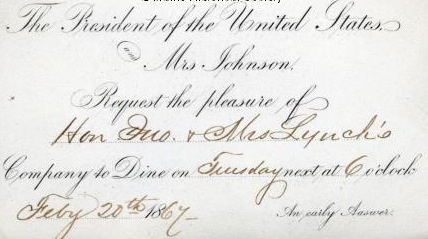 Suggestions that Eliza Johnson remained closed within the company of her family clan are also false. She formed friendships ranging from Isabelle Roest de Limbourg, wife of the Minister from the Netherlands to the U.S., to member of the Lawrence family which founded the town of Bayside, on New York’s Long Island. Suggestions that Eliza Johnson remained closed within the company of her family clan are also false. She formed friendships ranging from Isabelle Roest de Limbourg, wife of the Minister from the Netherlands to the U.S., to member of the Lawrence family which founded the town of Bayside, on New York’s Long Island.
Although the First Lady appeared outdoors to watch her grandchildren join the Easter Egg Roll festivities (which had informally begun during the Lincoln Administration), she stayed on the White House South Portico and thus remained inaccessible to the general public. Nevertheless, she received numerous letters from the public, usually being attempts to bring a matter before the President rather than address an issue related to her. Responding correspondence was handled by her daughters or the executive staff. There is no documentation that Mrs. Johnson ever answered the letters she received from strangers. One public gesture which Eliza Johnson purposefully made as First Lady that perpetuated an important degree of political symbolism about the Johnson Administration’s Reconstruction policy has been largely ignored by historians. In 1867, the First Lady agreed to participate in a fundraising effort which garnered national attention. In response to Baltimore philanthropist Josephine Newcomb, who was seeking to create a large orphanage for thousands of southern children left without parents as a result of the Civil War, Eliza Johnson donated some personal items to be publicly auctioned in the fundraising effort. The orphanage was to be located in Charleston, South Carolina with the intention of it becoming the largest in the South.  That the orphanage would be racially segregated, with only white children, was not unusual for the time and unlikely the point of appeal for the First Lady. However, since the orphans came overwhelmingly from the poor working class may, perhaps, have been a factor, considering the President’s Reconstruction policy being overtly intended to support that social stratum, from which both he and his wife emerged. A second detail in the episode of Eliza Johnson’s support of the southern orphanage carried further political implication, and one which would have first been approved by the President. The First Lady agreed to let her name be used in newspaper publicity about the fundraiser, alongside women famously associated with the Confederacy: thus, Eliza Johnson, wife of the United States President was linked to Varina Davis, wife of the deposed Confederate States President and Mary Lee, the daughter of the Confederate General Robert E. Lee. That the orphanage would be racially segregated, with only white children, was not unusual for the time and unlikely the point of appeal for the First Lady. However, since the orphans came overwhelmingly from the poor working class may, perhaps, have been a factor, considering the President’s Reconstruction policy being overtly intended to support that social stratum, from which both he and his wife emerged. A second detail in the episode of Eliza Johnson’s support of the southern orphanage carried further political implication, and one which would have first been approved by the President. The First Lady agreed to let her name be used in newspaper publicity about the fundraiser, alongside women famously associated with the Confederacy: thus, Eliza Johnson, wife of the United States President was linked to Varina Davis, wife of the deposed Confederate States President and Mary Lee, the daughter of the Confederate General Robert E. Lee.
Eliza Johnson also figures in another previously ignored incident. Though her role is not explicit, it does suggest she had an adamant bias favoring the southern white working class versus the wealthy planter class, rather than a blanket favoring of the Confederate South over the Union North, a viewpoint reflected in the President’s Reconstruction policy. As the Tennessee Military Governor’s wife, Eliza Johnson had lived from the spring of 1863 to the spring of 1865 with her family in a large and beautiful Nashville mansion on Charlotte Avenue. The house had been confiscated from its Confederate owner, Lizinka Campbell Brown Ewall, with whom Eliza Johnson and her daughter Martha Patterson were, in fact, social friends.  With extensive land holdings, which she managed as an independent businesswoman, daughter of a former U.S. Minister to Russia, and friend of the Russian Czarina, Lizinka Ewall was a prominent leader of Nashville’s social elite. Fleeing her home there after Union occupation in 1862 she then married Confederate general Richard S. Ewall and assumed management of his military affairs. In early 1865, however, Mrs. Ewall returned to Nashville with a note to Eliza Johnson asking for “use of one or two rooms in my own house.” Eliza Johnson would not respond. Ewall’s daughter, however, later revealed that “subsequent events” (for which she provided no details) proved that “Mrs. Johnson showed it to her husband.” Whether it was the nature of Ewall’s demand or the confrontation manner in which it was made, Eliza Johnson had taken offense from it and this influenced not only her husband’s decision to relinquish no part of the house but to also deny and delay Ewall’s plea to have her husband released early as a prisoner of war. In her 13 July 1865 note to him, even Ewall acknowledges that making her plea was likely “making some mistake as in my note to Mrs. Johnson.” With extensive land holdings, which she managed as an independent businesswoman, daughter of a former U.S. Minister to Russia, and friend of the Russian Czarina, Lizinka Ewall was a prominent leader of Nashville’s social elite. Fleeing her home there after Union occupation in 1862 she then married Confederate general Richard S. Ewall and assumed management of his military affairs. In early 1865, however, Mrs. Ewall returned to Nashville with a note to Eliza Johnson asking for “use of one or two rooms in my own house.” Eliza Johnson would not respond. Ewall’s daughter, however, later revealed that “subsequent events” (for which she provided no details) proved that “Mrs. Johnson showed it to her husband.” Whether it was the nature of Ewall’s demand or the confrontation manner in which it was made, Eliza Johnson had taken offense from it and this influenced not only her husband’s decision to relinquish no part of the house but to also deny and delay Ewall’s plea to have her husband released early as a prisoner of war. In her 13 July 1865 note to him, even Ewall acknowledges that making her plea was likely “making some mistake as in my note to Mrs. Johnson.”
Several of Johnson’s contemporaneous biographers credit Eliza Johnson’s sagacity as a guide for him through his political rise. One source termed her a “counsellor” and “assistant.” Tracing the potential political decisions or policy her personal and emotional influence on him may have led to is difficult to assess. In examining the second floor configuration during the Johnson Administration, the oft-repeated claim that her sitting room was directly across the hall from his office seems dubious, since that space had already been appropriated for use as executive offices; more likely it seems the office referred to was a sitting room in the President’s personal suite, in which he likely worked and held private meetings. While the political animosity towards Johnson was based on his policy decisions, his irascible moods and impulsive bluntness discouraged his enemies from seeking compromise. Eliza Johnson’s greatest influence was an ability to defuse and reduce his confrontational rhetoric, greater discipline further serving his purposes. Her management of his public wardrobe was further evidence of her conscientiously maintaining his presidential dignity. She was also noted for wearing elegant clothing made from expensive fabrics. To what degree President Johnson shared with her the details of his conflicts on Reconstruction policy with the Republican leaders in Congress and the subsequent 1868 trial for his impeachment and removal from office is unclear. However, Eliza Johnson kept herself fully apprized of the proceedings, making a close daily reading of political stories related to her husband from a variety of newspapers which she then clipped with a scissor and preserved in scrapbooks. Anecdotal claims pose her as showing him articles supportive of him in the evenings and those critical in the morning. Throughout the ordeal, she claimed to always believe he would be acquitted and she was overcome with emotional relief when she received confirmation of this prediction. Evidence of his era’s racist attitude towards recently-freed African-American slaves is now widely attributed to Andrew Johnson, but there is scant evidence to draw any conclusion about Eliza Johnson. It has been speculated that the abolitionist policy of her Methodist Church put her at odds with her husband having bought slaves to work in their Tennessee home. At the least, there are accounts of her great personal concern for the well-being of African-American servants at the White House, to the point of her ordering that financial aid and medical care for provided for them.  Although she was First Lady before the critical momentum of the suffrage movement advocating the right to vote for women began, there is indication that Eliza Johnson believed in some degree of gender equality. Perhaps under the guidance of her mother from New England, where equal public education for female students was first enacted, Eliza Johnson was herself formally educated and insisted that both of her daughters receive that same chance, at the best possible institutions the family could afford, even though it separated her from the two girls who were, essentially, her closest friends. Further, after her daughter Martha had accepted her marriage proposal, the prospective groom approached Andrew Johnson for formal permission to marry. Johnson responded to David Patterson that, as the woman’s father, he had right to prevent or encourage what was her right to decide. It is unlikely Johnson would have so consciously expressed this unusual view had Eliza Johnson not fully shared it. Although she was First Lady before the critical momentum of the suffrage movement advocating the right to vote for women began, there is indication that Eliza Johnson believed in some degree of gender equality. Perhaps under the guidance of her mother from New England, where equal public education for female students was first enacted, Eliza Johnson was herself formally educated and insisted that both of her daughters receive that same chance, at the best possible institutions the family could afford, even though it separated her from the two girls who were, essentially, her closest friends. Further, after her daughter Martha had accepted her marriage proposal, the prospective groom approached Andrew Johnson for formal permission to marry. Johnson responded to David Patterson that, as the woman’s father, he had right to prevent or encourage what was her right to decide. It is unlikely Johnson would have so consciously expressed this unusual view had Eliza Johnson not fully shared it.
Life after the White House: The relief Eliza Johnson felt upon returning to her Greeneville home was lifted with hope seven weeks after the presidency ended as her widowed daughter Mary remarried. Just one week later, it was shattered on 27 April 1869, when the body of her son Robert Johnson was found in the house, a victim of his own suicide. This second death of an adult son, impacted by his alcoholism left Eliza Johnson broken in spirit, although the temperance pledge of her remaining son Frank, daughter Mary Stover’s remarriage, and the former president’s vindicating 1875 U.S. Senate election helped divert some of her attention on the tragedy. While the former president and his wife were in the home of Mary Stover Brown, he suffered a stroke and died. Eliza Johnson was too weak to attend his funeral service. She died five and a half months later.Death and Burial: 15 January 1876
Greeneville, Tennessee
Andrew Johnson National Cemetery
Greeneville, Tennessee Martha Johnson Patterson Daughter and Hostess for her father, Andrew Johnson 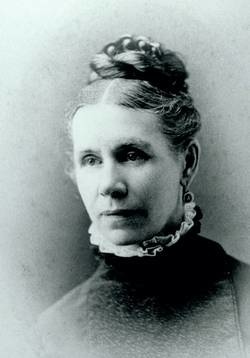
Birth: 25 October 1828 Greeneville, Tennessee Early Life: Andrew Johnson once declared Martha to be “my favorite child,” and from her earliest years, his oldest child was as strongly influenced by him as her mother. Organized, decisive, comfortable with business matters, strong in her views and facile with language, and with a natural ability to judge distance and make mathematical conclusions in her head, Martha Johnson was remembered as a serious, with a “masculine” mind. During the frequent absence of her father and resulting necessity of aiding her mother’s numerous responsibilities, as a young woman Martha Johnson helped in the care of her four younger siblings, cultivated and harvested the family’s vegetable gardens, and maintained the care and cleanliness of their home. Martha Johnson also joined her mother in visiting the county homes and institutions supported by their Methodist Church of those who were either disabled, ill or in other ways dependant on help. Her generosity in helping those in need remained an element throughout her life, even to the point of sacrificing what she had to share with those in need. It created in her a strong commitment to benevolent organizations. With a political sensibility clearly affected by her father’s view of the working class, Martha Johnson was described as a “firm advocate of those less fortunate than herself.” Attending local public school, Martha Johnson was never known to play outside or join her fellow students and friends in any amusements. Influenced by her mother’s own habits, Martha Johnson also showed no interest in fancy clothing or any material ostentation. While there is the suggestion that Eliza Johnson encouraged Martha to divert herself in some amusement outside of her work at home, her daughter resisted the offer. One neighbor termed her “a strange, silent being.” Whether or not it was due to her parents intending to socialize her, or to serve as a family companion to her father, she was sent by them along with him to Washington, D.C. when he first went to serve in Congress. Education: Miss L. English’s Female Seminary, Washington, D.C. (January 1843- December 1847) Martha Johnson received a rigorous education in the classics, mathematics, sciences, history, geography, grammar, composition, as well as subjects taught young women in preparation for social life, including French, music and needlepoint. She was enrolled at the Miss English Seminary for three semesters. Rather than return home to Tennessee during the breaks between semesters or taken out of school when her father was on congressional break, she lived as a long-term guest during those times in the White House, as the guest of the President and Mrs. Polk, Tennessee natives and political allies of her father. In later life, with humorous self-deprecation, she often recalled her timid and distant nature during her youthful period in the White House and how not even the patient guidance of Sarah Polk could reverse her “shrinking reserve.” However, she used the time to acutely observe the behavior of political figures. She determined as a young woman to marry a man who was not only interested in politics but had the potential to rise to the high regard she held for her father. 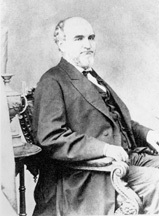
Marriage 27 years old, on 13 December 1855 to David Trotter Patterson (born 28 February, 1818, Cedar Creek, Tennessee, died 3 November 1891, Afton, Tennessee) Washington, D.C. Martha Johnson continued to live in Washington, D.C. with her father, both of them returning to Tennessee during his congressional breaks. She returned to live there in 1851. Shortly after, at age twenty-three, she met law clerk David Patterson. Despite his being ten years her senior, they were a strong match in their love of politics and Martha half-joked that she would not marry him until he could prove his ability to rise in elective office. In fact, not until one year after Patterson had begun his work as a Tennessee Circuit Court Judge (1854-1863) did they marry. Holding a quiet ceremony at home with no wedding festivities after, the couple did take a honeymoon tour of several southern cities, including Nashville and New Orleans. Martha Patterson had married relatively late, at the age of 27 years old and did not have her first child until the age of 29 years old, after which she assumed the traditional role of housekeeper and mother, but also continued her role as aide and confidante to her father. Children: Two children, one daughter, one son: Mary Belle Patterson (Landstreet) (11 November 1857 – 9 July 1891); Andrew Johnson Patterson (25 February 1859 – 25 June 1932) The outbreak of the Civil War found Martha Patterson living near her parents’ home in Greeneville until late 1862 when she relocated to Nashville. During her absence, the interior of the vacated Patterson home was ransacked by both Union and Confederate troops, its furnishings either stolen or broken. She made one trip there to survey the damage, but returned to live with her family in Nashville, while her father was serving as Military Governor of Tennessee. 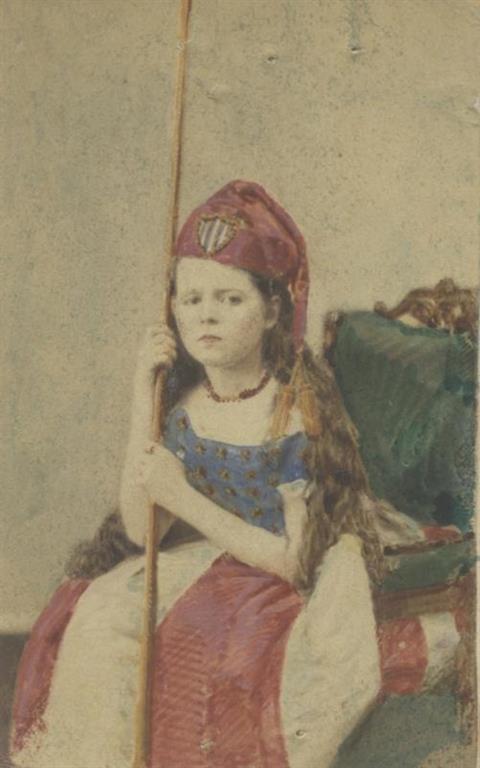
Martha Patterson took brief comfort in Nashville’s celebration by Union loyalists over the news that her father was nominated, elected and sworn-in as President Lincoln’s Vice President. After learning of his ascension to the presidency, following the assassination of President Lincoln, Martha Patterson participated in a 19 April 1865 Nashville mourning procession for the late president, riding with former First Lady Sarah Polk in her closed carriage, which followed behind those of several Union generals. White House Years: Under the direction of her mother, First Lady Eliza Johnson, Martha Patterson assumed great responsibility for the Johnson Administration White House, playing several different roles. Foremost was that of the primary hostess who welcomed the general public and invited guests, aided by her sister Mary Stover. The family had inherited a post-war mansion, the appearance of which denigrated the presidency. There were flea, termite and other vermin in the soiled furniture, carpets were worn and curtains were tattered from handling and also souvenir hunters. Martha Patterson immediately worked on cleaning the state floor and making it presentable, assuming the job of housekeeper and assigning tasks to the servants. At the family’s first public appearance, at the 1866 New Year’s Day Reception, the Marine Band music, presence of the small presidential grandchildren and their friends, and a profusion of flowers helped distract the crowds from the removed East Room furniture and the soiled rugs being covered in linen. She also efficiently streamlined the cloakroom procedures for arriving and departing guests, resulting in no delay of their greeting the President. 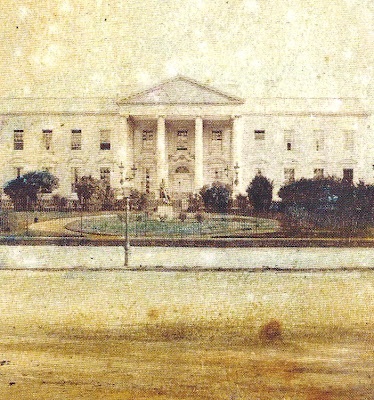
As First Lady, she used considerable skill in assuming the personal management of an April 1866 $30,000 congressional redecorating appropriation. Rather than expend it on the private quarters and executive offices alone, she apportioned it with tremendous care and consciousness so that the overall appearance of the public rooms was uplifted. Rather than purchase new and expensive items, she had furniture repaired and recovered. Unable to afford new papering of all the state rooms, she had panels and gilt decorations affixed to them. The wood floors, doors and trim were refinished and repainted. Rather than expend any of the appropriation to pay interior design contractors, Martha Patterson made all the purchases and directed the carpenters, painters and reupholsters herself. She worked on the project alongside them through the intense heat of Washington’s summer to ensure the project’s completion by the fall social season of 1866. 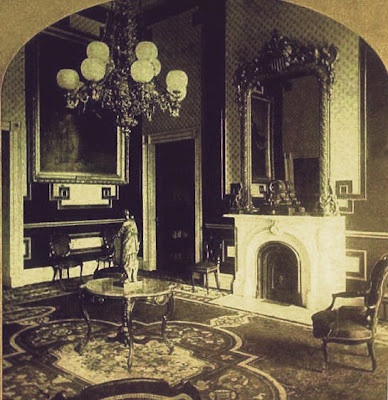 Under Martha Patterson’s stewardship, there was a conscientious effort to begin a collection of portraits of former residents, including those of Martin Van Buren, John Quincy Adams, John Tyler, James Polk, Millard Fillmore, Franklin Pierce, Angelica Van Buren, Sarah Polk and Julia Tyler. Hung on the wall of the cross hall of the state floor, President Johnson was especially proud of the small gallery created by his daughter and enjoying telling stories about his predecessors as he and guests strolled by each one. Mrs. Tyler personally presented her own portrait for the fledgling collection. Under Martha Patterson’s stewardship, there was a conscientious effort to begin a collection of portraits of former residents, including those of Martin Van Buren, John Quincy Adams, John Tyler, James Polk, Millard Fillmore, Franklin Pierce, Angelica Van Buren, Sarah Polk and Julia Tyler. Hung on the wall of the cross hall of the state floor, President Johnson was especially proud of the small gallery created by his daughter and enjoying telling stories about his predecessors as he and guests strolled by each one. Mrs. Tyler personally presented her own portrait for the fledgling collection.
Martha Patterson expended no considerable public funds on the living area of the presidential family. Despite Lincoln’s assassination, security there was lax; Martha Patterson often found herself having to politely ask tourists, office-seekers and others who had managed to find their way into their living rooms to return to the public rooms. Martha Patterson took on one a task of manual labor as well. For the production of dairy foods served to both the family and guests, she dressed in a calico smock and apron each morning, then milked the several cows in the White House dairy and skimmed the milk, keeping her milk pails in a hall which connected the greenhouse to the White House. Although her mother Eliza Johnson seemed to be as directly involved in the food quality, Martha Patterson prided herself on having her own recipe for teacakes served to guests. She also focused on initiating elegant details at state dinners over which she presided with her father, despite her mother’s frequent but brief appearances at these public entertainments. Described as “generous and princely,” she had bouquets placed at each setting alongside what a contemporary description termed “green-gold” china. Limiting the number of dinner guests to forty, she had the main table decorated with large and long gold centerpieces from France, purchased under Monroe’s Administration. Hosting these in the State Dining Room, which had been closed for use by Mary Lincoln in the previous Administration, she also had the room photographed for the first time, when it was fully prepared for a formal dinner. While emphasis has been placed on Martha Patterson’s importance in her welcoming the general public at receptions and distinguished guests at state dinners, from her perspective the importance of her role was derived from the comfort it provided her father as President, whether seated directly across the table from him or standing alongside him. The value of her presence, said one observer was the “relieving him of much of the necessity of entertaining” by extensive personal interactions. Such wariness was based on the acrimony felt towards him and his policies by the “Radical Republicans” who held dominant power in Congress and his inherited Cabinet, and who led the move to impeach and remove him from the presidency. Martha Patterson’s husband also lived in the White House with the extended Johnson family. His election to the U.S. Senate to represent post-Civil War Tennessee (1866-1869) had him serving in the government body which proceeded with the impeachment of his father-in-law President Andrew Johnson. His political position also made Martha Patterson both a presidential daughter and Senate wife; not since Maria Jefferson Eppes and Martha Jefferson Randolph, whose husbands served in the U.S. Congress while their father lived in the White House as President (where they visited but did not live) had there been any similar situation. Publicly, Martha Patterson maintained the impression that as a Senate wife she played no political role as a Presidential daughter. When asked about the impeachment trial, she responded with bland caution, “I have so much to do, that I have no time to discuss the subject, and I suppose my private opinion is not worth much; I do not know how it will end, but all we can do is to wait." On at least one occasion, however, Martha Patterson slipped into the first row of the visitor’s gallery to listen to the Senate impeachment trial proceedings of her father, cloaked in her cape but not escaping the notice of a pen-sketch illustrator. 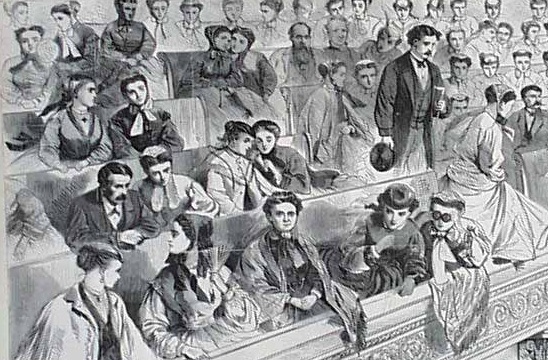
During the impeachment trials, she was also a figure of calm and strength within the Johnson clan. Martha Patterson managed to calmly integrate the reality that the family might potentially be forced to return home to Tennessee if her father’s impeachment resulted in his removal from office. Her sense of balance during the anxious months of the impeachment was a continuum of the emotional strength she showed while serving as her mother’s assistant while a child, and the trials endured during the Civil War. When President Johnson was acquitted, however, Martha Patterson gave way to a necessary relief from the stress she had been feeling yet withholding from being detected. She was suddenly unavailable to any callers or to greet the public, her sister Mary Stover temporarily substituting for her. It hadn’t been the impeachment trials alone which led the Johnson family to feel resentment and suspicion towards many outsiders. Martha Patterson was repeatedly beset by women seeking to have their Confederate relatives either released from Union prisons or pardoned, as well as those persisting pursuing her to intercede and spare the life of accused Lincoln assassination conspirator Mary Surratt. To all such callers, Martha Patterson stonewalled; despite being the president’s daughter, her opinion had no more power to influence him, she claimed, than that of any other person and that was the legally correct attitude to hold. In September of 1867, Martha Patterson had also accompanied her father on his presidential tour of northern and western states, the first time a woman of a presidential family had done so since Priscilla Tyler joined her father-in-law on his 1840s tour. From the rear platform of his train, from which President Johnson spoke, Martha Patterson silently watched and listened in horror as mobs yelled bitter, demeaning and derisive insults at her father. No evidence suggesting her verbal interactions with the President were anything but personal in nature, she was termed his “counsellor and friend,” for the emotional support she provided him through one of the most trying Administrations to that time, rather than offering any political strategy or philosophy. Where she lacked familiarity with literature or world cultures, her admirers pointed out, Martha Patterson excelled by “will-power,” “common-sense,” and “ceaseless industry.” As she famously explained of the family’s intentional image, “We are a plain people, sir, from the mountains of Tennessee, and we do not propose to put on airs because we have the fortune to occupy this place for a little while." 
Like her mother and sister, Martha Patterson arranged her visual appearance to convey a democratic simplicity with dignified elegance, wearing none of the ostentatious frills popular in that era, but rather simply cut clothing which evoked a classical Greek toga style, though made of expensive velvets, with little to no jewelry, and often a cape or shawl. She invariably dressed her hair in a long and simple ponytail, marked only with a fresh flower. Many of the leading political wives and daughters considered Martha Patterson to be “unfashionable,” but that may have been more of a sentiment in reaction to her “distant and reserved” treatment of them, rather than her appearance alone. In contrast to her attitude towards the privileged wealthy class, Martha Patterson sought to have the public rooms kept clean and clear of clutter for the benefit of the working-class that might appear to tour the historic mansion. She was hailed by the common man for her refusal to accept any gifts or presents simply because fate had made her a presidential daughter. Despite the belated goodwill towards the family expressed by the estimated five thousand callers at the last Johnson Administration reception, and another five thousand who were unable to make it in through the crowd, Martha Patterson reflected, “I am glad this is the last of entertainments—it suits me better to be quiet and in my own home. Mother is not able to enjoy these things. Belle [her daughter] is too young, and I am indifferent to them—so it is well it is almost over.” After the White House As the Johnson family prepared to leave Washington for their Tennessee homes, Martha Patterson made certain that they took with them nothing but items purchased by their own funds or a few state gifts presented to them personally from visiting dignitaries or heads of state. The former President and First Lady were honored at the home of Senator Coyle, while Martha Patterson was separately honored at the home of her father’s Treasury Secretary. At the request of the household servants, Martha Patterson sat for her photograph and gave a copy to each of them and further arranged for her parents, siblings, children, niece and nephew to do so, and gave copies of their images to the staff as well. Some chroniclers felt the need to praise her at the expense of Mary Lincoln, one writing that she “redeemed the position she held from the slur and slander attached to it. Across the lapse of years she clasps hands with Miss Lane, and restores to its former pristine glory the title of hostess of the President's House.” Upon her return to Tennessee, Martha Patterson oversaw extensive renovations to her home, building the addition of a sewing room for herself and the planting and cultivating of a vegetable and flower garden. As her mother’s health worsened, she became more of a direct caretaker for her. Following the death of her parents less than seven years after they’d left the White House, she continued to defend his public record and maintain their home with its historic objects, all of which was eventually preserved by her granddaughter who lived to see it become a national historic site. Widowed for the last decade of her life, she and her son were the last survivors of those who’d lived in the White House and she became reclusive to visitors, granting only one interview in the ensuing years. Death and Burial: 10 July 1901 Greeneville, Tennessee Mary Johnson Stover Brown Birth: 8 May 1832 Greeneville, Tennessee ![Though highly uncomfortable being a public figure, Mary Johnson Stover [Brown], aided her more prominent sister Martha Patterson who served as the Administration hostess at public events. (Andrew Johnson National Historic Site)](/images/biographies/ejohnson/johnson27.jpg)
Education: Odd Fellows Female Institute, Rogersville, Tennessee (approximately, 1850-1851).While the exact course of study taught to Mary Johnson in undocumented, it is know that a prominent southern portrait painter Samuel Shaver was teaching at the Institute while she was a student there. It is known that she, like her sister, had pursued her studies with the intention of becoming a school teacher, though she never did so. Located in what was the second-oldest town in the state, it is a distance of some 32 miles from Greeneville, where her family lived; too far to commute daily, she boarded in the town there. Marriage: 27 April 1852, Greeneville, Tennessee, to Colonel Daniel Stover, Jr. plantation owner, (born 14 November 1826, Carter County, Tennessee, killed 18 December 1864, Nashville, Tennessee). How Mary Johnson and Daniel Stover met is unclear, but it would have taken place at the time she was completing her formal education. Mary Stover married secondly, 20 April 1869, to William Ramsey Brown, merchant, (dates and place of birth and death unknown), divorced, 1876 Children: Three children, two daughters, one son: Lily Stover (11- May 1855 – 5 November 1892); Sarah Drake Stover (27 June 1857 – 22 March 1886); Andrew Johnson Stover (6 March 1860 – 25 January 1923) Early Years Mary Johnson’s father-in-law (William Stover) and Abraham Lincoln were both great-nephews of Isaac Lincoln, who owned extensive farm property and African-American slaves in Carter County, Tennessee. Abraham Lincoln’s father, Thomas Lincoln worked on the property as a farmhand and also courted Nancy Hanks. Tradition holds that prior to departing for Kentucky they lived briefly as common-law spouses in a stone cabin there. The property passed into the Stover line to Mary Johnson’s husband and then, upon his death, to her solely. Former President Andrew Johnson died here. 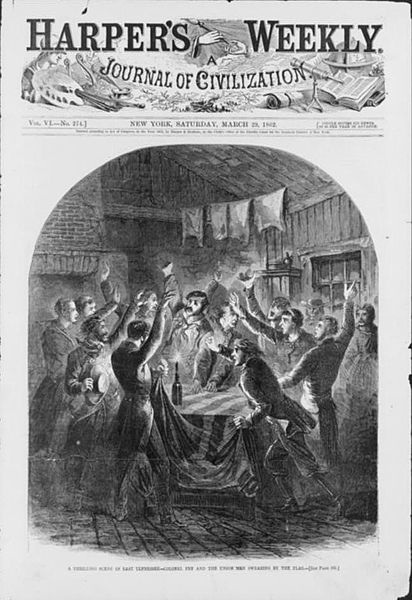
In 1861, Stover was among the first Union supporters in his region who volunteered for a brigade known as the “The Bridge Burners,” which identified and destroyed the bridges which were primarily used to transfer Confederate supplies. On 8 November 1861, he led the burning of the Holston River. For this he was hunted down, targeted for capture by Confederate troops. This forced Stover and his men to seek refuge in the caves of the nearby mountains during the subsequent winter months and he contracted tuberculosis. Most of the other men were among the working poor with families unable to provide their own sustenance. Mary Stover directed that her farm’s livestock be slaughtered to keep the families fed. Not wanting to tip off the Confederates searching for the militia in the mountains, however, often inhibited her from smuggling the food baskets she and her mother prepared for them. Many often starved or froze to death in the mountains, a fact which weighed heavily on her. After her husband managed to obtain permission to pass through enemy lines, Mary Stover escorted her mother to Kentucky, while Daniel helped raise a regiment of Tennessee volunteers who had fled across the state line. Upon her husband’s death, she returned to their farm and found the buildings destroyed and the food reserves depleted. Widowed, she and her three children lived with her parents in Nashville. After their father became President, Martha Patterson proceeded to join him in Washington while Mary Stover remained behind in Tennessee with her brothers, mother, three children, one niece and one nephew. White House Years A month after arriving in Washington with her family entourage, Mary Stover returned home for twenty days, on 3 October 1865, to receive her late husband’s remains from a temporary holding place and arrange for his burial. When she returned to the White House, Mary Stover served two designated roles in the Andrew Johnson Administration. Her primary one was to manage the five small children who lived in the White House and integrate them the President’s day as well as the public life of the mansion. Through his grandchildren, Andrew Johnson drew comfort and anticipated the distraction from his contentious work as President. While Mary Stover insured that he was not interrupted when he worked, she had the children gathered and ready to spend time with him in the evenings, after their dinner. During the day, she arranged with local school and music tutors to instruct them, with the orders for reasonable quiet since the executive offices shared the same floor as the family rooms. After their training, they were brought to spend time with Eliza Johnson, and then allowed to play outdoors or escorted to dance lessons at a studio nearby. Returned for dinner, they were then joined by the President. Mary Stover spent much of her time with the children as they proceeded with their schedules; having been trained as a school teacher, it was a task she enjoyed. The greatest personal compliment she received was being called a “judicious mother.' During the summers of 1865, 1866, 1867 and 1868, Mary Stover took her children and niece and nephew and returned to the more pastoral setting of their Tennessee home. Before leaving Washington, Mary Stover fulfilled a promise to the children of taking them on a first trip to New York City for several days. 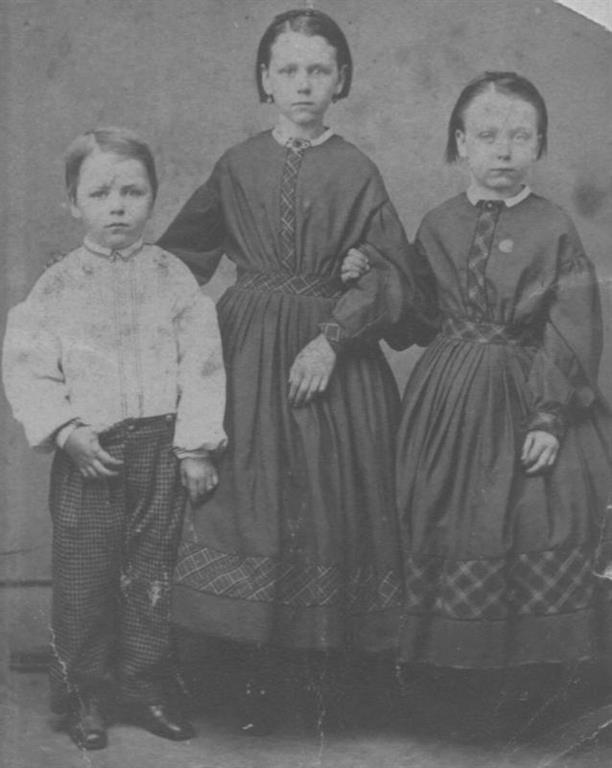
Mary Stover instigated and arranged one of the most unique social events held at the White House. Held just weeks before the Johnson family left Washington to return home, it was ostensibly to honor the President on his birthday of 29 December 1868. Taking place at the height of the social season schedule and engaging three generations of the First Family, it generated goodwill towards the departing Administration after its years of acrimony. The official hosts were listed as “The children of the President's family,” and the event was a dinner and dance for three hundred other young children, not only the offspring of political officials and prominent Washingtonians, but those of the white working class. Any adults in attendance were there as a guest of their children, and Mary Stover was “considerably embarrassed by requests from grown people to be included among the invited.” Held in the East Room, the central focus was a temporary stage, covered in pink cloth and festooned with holiday-season evergreen garlands. From here, the Marine Band played a series of dance music movements. In the four corners were flower-stands with small bouquets for each child. At seven in the evening, with the adults standing along the walls, a Washington dance teacher led two lines of boys and girls in; forming into couples they fell into line and began a formal promenade which mimicked those performed by adults. Eliza Johnson remained seated during the event, while the President, Martha Patterson and Mary Stover mixed among the children. After six dance performances, they proceeded to the State Dining Room for an intermission of fruits and desserts. Her second role was one she least enjoyed; to serve as either a support hostess at those public events over which her sister Martha Patterson dominated or to substitute for her as the primary hostess. The statuesque, auburn-haired president’s daughter defied popular styles by wearing high-necked, long-sleeved and dark-colored gowns, and no jewelry. Reserved but not a shy person, her interactions with the politically and socially prominent guests were decidedly aloof. With such guests, she resisted responding to personal questions and even well-intentioned inquiries about the First Lady, often failed to learn their names, and displayed “coldness,” towards flatterers and those offering social invitations and unsolicited advice. In reaction, many found her “distant and haughty.” Eager to usher them through the receiving line and shown out as soon as was politely possible, she became animated only as the Marine Band began playing their final selection of the evening. Afterwards, she gathered a few Tennessee friends in her upstairs room, reviewing details of her ordeal with laughter. When, at the last Johnson reception, Mary Stover became suddenly expressive in her farewell to the social leaders, many questioned her sincerity. An otherwise unaffected person, Mary Stover’s interactions with guests of the working classes suggest that she viewed her hostess role within the political context of her father’s political philosophy and the strife of his Administration. She displayed overt warmth and fully engaged with those local seamstresses and store clerks she met at public receptions. They, in turn, felt comfortable in her presence. She was especially sensitive to visitors from rural areas, insecure and uncertain of proper behavior in the presidential mansion. Like her mother and sister, Mary Stover also strove to ascertain the well-being of the White House’s African-American and white servants and their families, and provide for any health care they might need. After the White House A month before the Johnson Administration ended, Mary Stover preceded her parents to Tennessee in order to ensure that new wallpapering and carpeting had been placed in their home, which had been ransacked and damaged during the Civil War. Her second marriage, to the merchant William Brown took place just seven weeks after her father’s presidency ended. A widower, Brown had four children by his first marriage and with Stover’s three children they created a lively presence which distracted the infirm former First Lady. In the early months of their marriage, the Browns lived across the street from her parents. At what point and for what specific reasons difficulties in her second marriage arose are not known. However, Mary Johnson Stover Brown did not divorce William Brown until after both of her parents had died. She continued to reside in northeastern Tennessee, a part of the family life of her adult children. Death and Burial: 19 April 1883
Bluff City, Tennessee
|